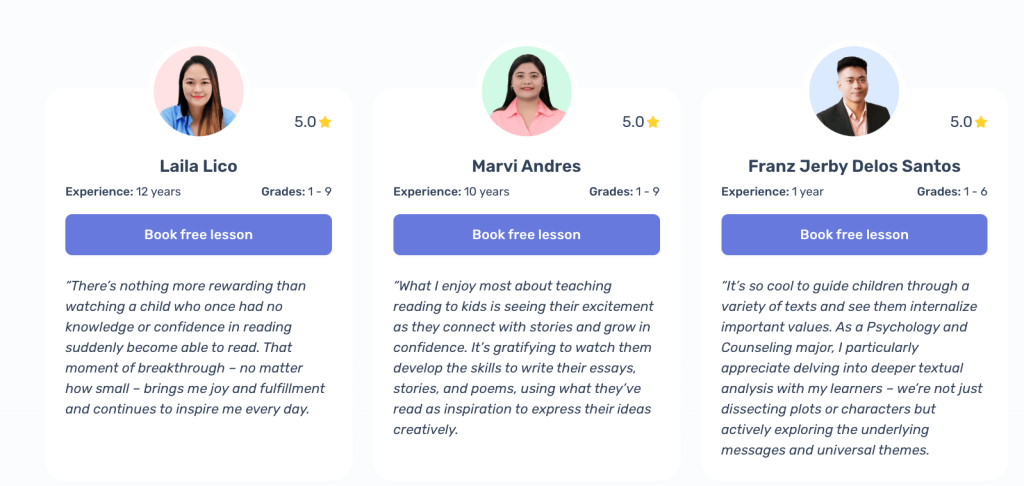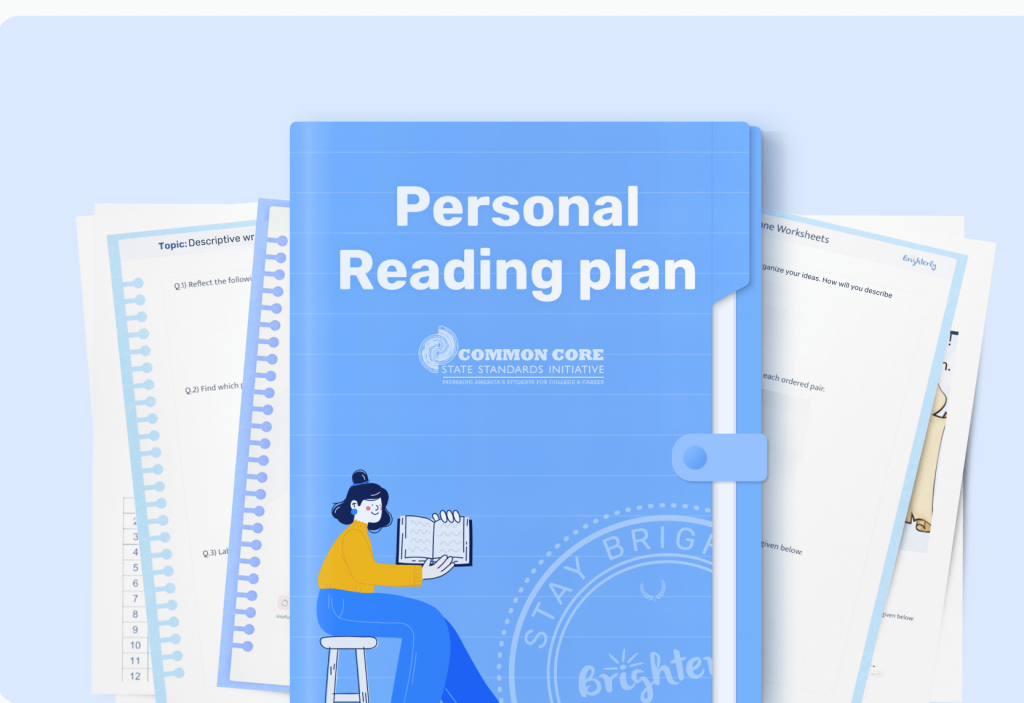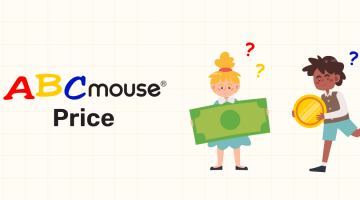Average Reading Speed by Age: Relevant Data in 2025
reviewed by Marvi M. Andres
Updated on September 16, 2025
As a teacher working with reading learners for years, one big concern I’ve noticed among parents is a child’s average reading speed. That’s why I decided to conduct this in-depth research, analyzing the numbers from the latest evaluations. So, here’s a comprehensive guide, designed to dispel all your doubts and provide only concrete information.
Key points
- The average WPM by age will fluctuate between 80 and 230 words for silent reading, with final numbers depending on the current child’s age.
- Each learner has a personal reading style that heavily defines their average WPM reading speed. However, if you devote enough time and attention, you can speed up their pace and so change the style they obtain.
- Studying with a reading tutor is the most productive way to improve average reading speed WPM, along with overall performance in the subject.
What is the average reading speed (WPM) by grade level?
The average reading speed can fluctuate between 80 words per minute (WPM) for 1st school graders and increase up to 300 WPM for high schoolers. That’s for silent reading. Regarding oral recitation, the average WPM reading numbers according to the Corn & Koenig research typically range from 60 to 200.
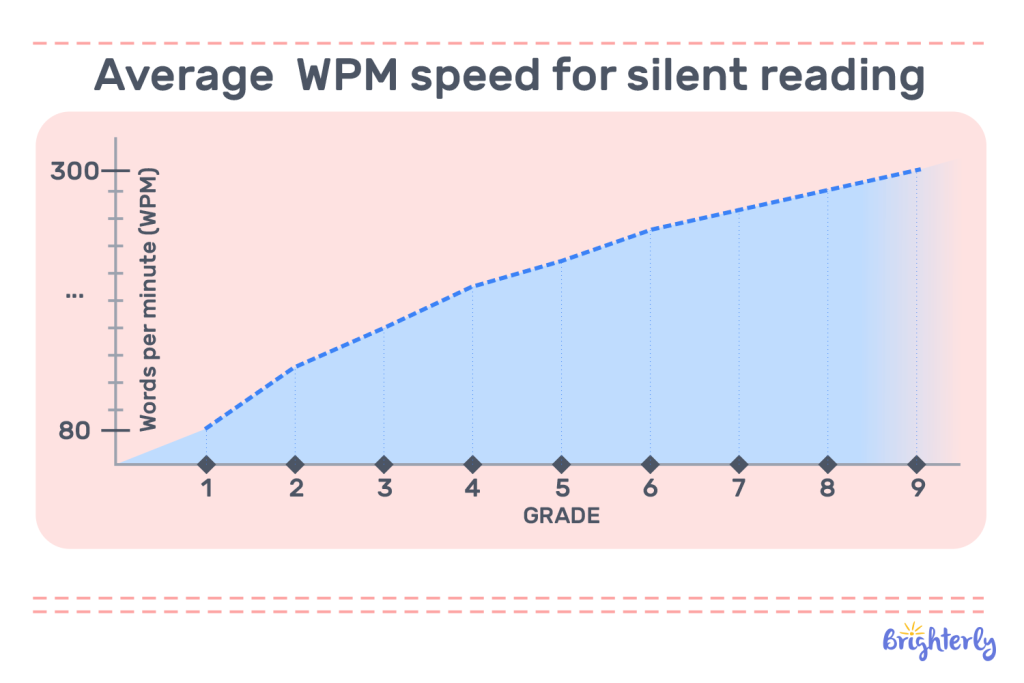
Reading words per minute by grade (elementary school students)
How many words a minute should a first grader read? |
80 WPM when reading silently 60 WPM when reading aloud |
Average words per minute reading 2nd grade |
80-110 WPM when reading silently 70 WPM when reading aloud |
How many words per minute should a 3rd grader read? |
110-130 WPM when reading silently 90 WPM when reading aloud |
How many words per minute should a 4th grader read |
130-150 WPM when reading silently 120 WPM when reading aloud |
How many words per minute should a 5th grader read |
150-160 WPM when reading silently 120 WPM when reading aloud |
How many words per minute should a 6th grader read |
160-175 WPM when reading silently 150 WPM when reading aloud |
How many words per minute should a middle and high school student read?
The average reading speed pages per minute, for kids in middle to high school, fluctuates between 150 and 300, increasing steadily throughout the grades. Also note that the number will be impaired mainly by the complexity of the text and individual peculiarities of your child.
How many words per minute should a 7th grader read? |
175-185 WPM when reading silently 150 WPM when reading aloud |
How many words per minute should an 8th grader read? |
185-200 WPM when reading silently 150 WPM when reading aloud |
How many words per minute should a 9th grader read? |
200-230 WPM when reading silently 155 WPM when reading aloud |
Increase reading speed with Brighterly tutor
Hiring a tutor may be your best decision to help your child rank high on that reading speed chart. That’s why I strongly advise you to consider the best reading program for kids called Brighterly. With this site, you will be matched with a teacher to take complete control over your kid’s learning. Thus, your effort and time expenditures will be minimized.
Additionally, there are some other benefits to consider:
- The online 1:1 tutoring format is the perfect fit for both learners and their reading tutors. It fosters better involvement and ensures that both parties can maintain a more explicit focus. This level of concentration is hardly achievable when practicing in groups.
- Each reading class at Brighterly corresponds to Common Core principles. Your initial request may be to improve the average reading speed by age. But what you’ll get with the platform is much more than that. Your child’s schedule will be accurately matched to their school program, guaranteeing more effective test preparation and overall better language skills.
- Last but not least, the reading program you’ll work with is perfectly customized towards individual needs. Before learning begins, students take a diagnostic test. Later, they undergo regular knowledge assessments. Then, their schedules are meticulously paced with their objectives and current performance.
One more thing I specifically like about Brighterly is its affordable price. I often spotted situations when e-learning websites imposed extra learning fees post-factum. But that’s definitely not about Brighterly! The pricing you agree to, according to the chosen plan, is the only fee you will ever incur.
Note: The Brighterly math and reading program has developed a collection of valuable knowledge self-check tests for children in grades 1 to 9. Simply choose their level and answer a few questions — now you know how much reading help they require.
What is the average reading speed pages per hour?
The average reading speed pages per hour usually fluctuates between 10 and 40 pages, depending on the child’s grade. The number is generally measured using fiction texts. However, it will surely decrease when we talk about non-fiction, industry-specific pieces.
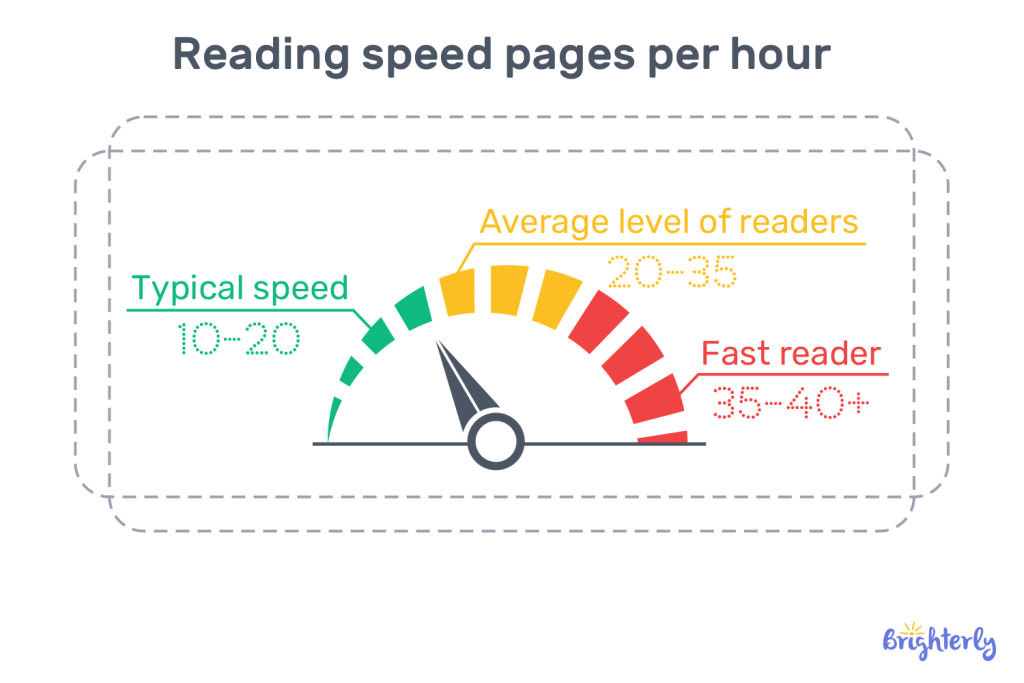
What is the average reading speed pages per hour by grade (elementary school students)?
What is the average reading speed pages per hour: 1st grade |
10-15 pages |
What is the average reading speed pages per hour: 2nd grade |
15-25 pages |
What is the average reading speed pages per hour: 3rd grade |
20-28 pages |
What is the average reading speed pages per hour: 4th grade |
25-30 pages |
What is the average reading speed pages per hour: 5th grade |
32-38 pages |
What is the average reading speed pages per hour: 6th grade |
40-45 pages |
What is the average reading speed pages per hour by grade (middle and high school students)?
The average reading speed pages per hour for middle to high school grades is usually between 40 and 60. Although parents won’t usually notice any significant changes through grades 6 to 8, WPM reading speed and the number of pages read are expected to increase steeply as kids move to high school.
What is the average reading speed pages per hour: 7th grade |
40-45 pages |
What is the average reading speed pages per hour: 8th grade |
40-45 pages |
What is the average reading speed pages per hour: 9th grade |
45-60 pages |
WPM average by age: How fast can adults read?
Research published in 2019 in the Journal of Memory and Language indicates that adults average 238 WPM for non-fiction and 260 WPM for fiction during silent reading. Regarding the average words per minute reading out loud pace, most reached the mark of 183 words per minute.
The research analyzed over 18,500 participants and surprisingly found that the average reading rate is lower than expected. When it comes to detailed ranges for silent reading, adults typically fall between:
- 175–300 WPM for non-fiction
- 200–320 WPM for fiction
Average WPM reading: Things to pay attention to
By this point, I’ve already mentioned that one feature you should consider when measuring the WPM average by age is the individual peculiarity of your kid. The paramount fact that parents often overlook is that each child (and also each adult!) has a different reading style, which determines whether they are faster or slower.
Now, let’s discuss the specific three styles and how they impact an average reading speed per page, as exemplified by kids in grade 8. I’ll start with the slowest readers and then steadily move to the speed champions.
Average WPM by age: Motor readers
These readers tend to silently pronounce each word, a phenomenon scientifically known as subvocalization. They tend to read more slowly, but their huge plus is an overall better comprehension. Thus, the average WPM for a 13-year-old is typically about 140–170.
Average WPM by age: Auditory readers
Auditory readers are in the middle of our chart. They usually process text by “hearing” the words in their mind without physically moving their lips or tongue. Children belonging to this type can score 180–210 in WPM.
Average WPM by age: Visual readers
Visual readers recognize words and phrases as visual units rather than sounding them out mentally. They skip the “hearing” stage entirely, and so can read much faster than both motor and auditory types. That’s why the average WPM for 14-year-old kids in the 8th grade can reach 220–250 WPM. Although the number itself is impressive, kids typically require extensive practice to achieve it.
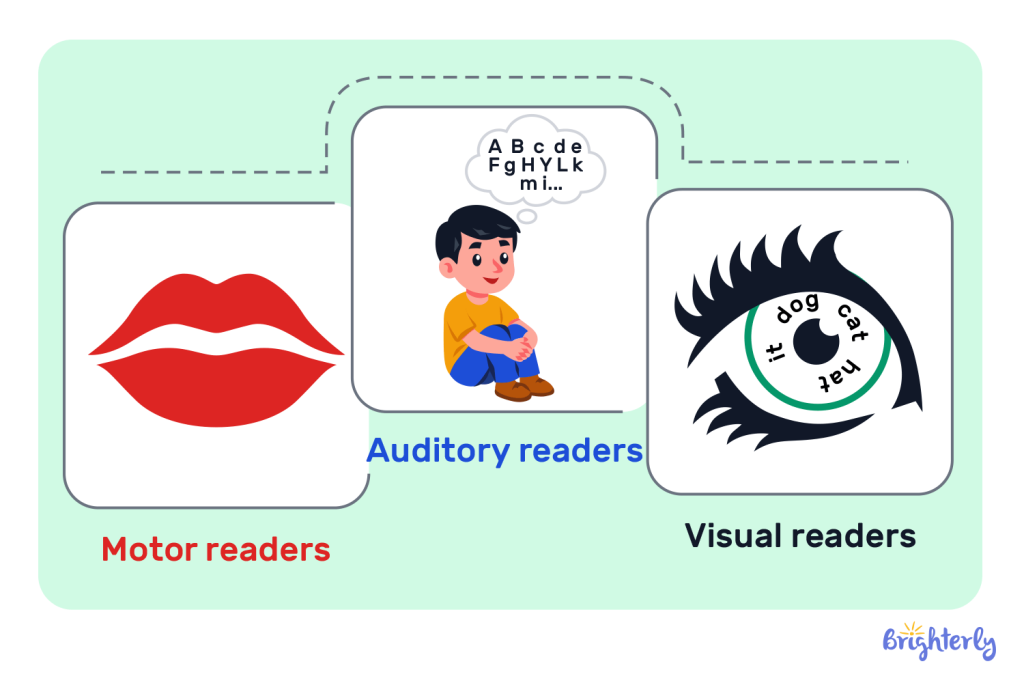
Is it possible to change a reading style?
Once you start perceiving the reading WPM chart through the prism of your child’s reading style, you might wonder if it is possible to change it. Well, it is! However, note that this requires lots of conscious, targeted practice.
Here, I’d like to share some brief yet working tips to make your reading ambition a reality:
- Youngest learners usually belong to the motor reading type. That’s why it’s so important to know how many words should a first grader read per minute and address any issues promptly. Use this method — ask the child to place a finger on their throat while reading silently and spot vocal cord vibrations. Train them to avoid these vibrations and use treats as a motivational tool.
- Use pacers, such as fingers, pens, or apps, to guide your eye movement more quickly.
- Instead of reading word by word, group 2–4 words per glance. You can use speed drills or specialized apps to help you develop this skill.
- Set a timer when reading and motivate the child to gradually increase their WPM by 10–20 words. But don’t forget to check their comprehension as their swiftness grows! Say, you’re measuring average words per minute reading 2nd grade. Then, you can realistically achieve a 10 WPM speed-up within 2 to 4 weeks of practice.
These ways are great, but there are many more techniques to explore. As the starting point, you can check out this article: How to Increase Reading Speed: 10 Best Methods. There, I’ve shared the top tips that, from my experience, proved most effective.
Average reading speed pages per minute: Measurement rules
How many words does the average person read per minute? Now, you have all the necessary numbers at hand. The final question is, how can you measure the reading speed to get the most relevant result?
Follow this guide to calculate your average reading speed:
- Choose the text you will use for testing. You can opt for:
- Magazines and online articles
- Novels
- Textbooks or scholarly articles
If you look for a complex reading speed percentile estimation, use these three text types at the same time. But if you want to complete a quick check, some fiction text is the best option. I wouldn’t recommend using non-fiction, as they can vary significantly in complexity and thus impair the final results.
- Set a 1-minute timer and then count the number of words you read in that period for all text types you use.
- It will give you three scores, from easy to difficult level.
- Next, check your scores against the average reading speed by age WPM chart. If you see that your lowest result doesn’t match the industry average, it may be the right time to take up some practice.
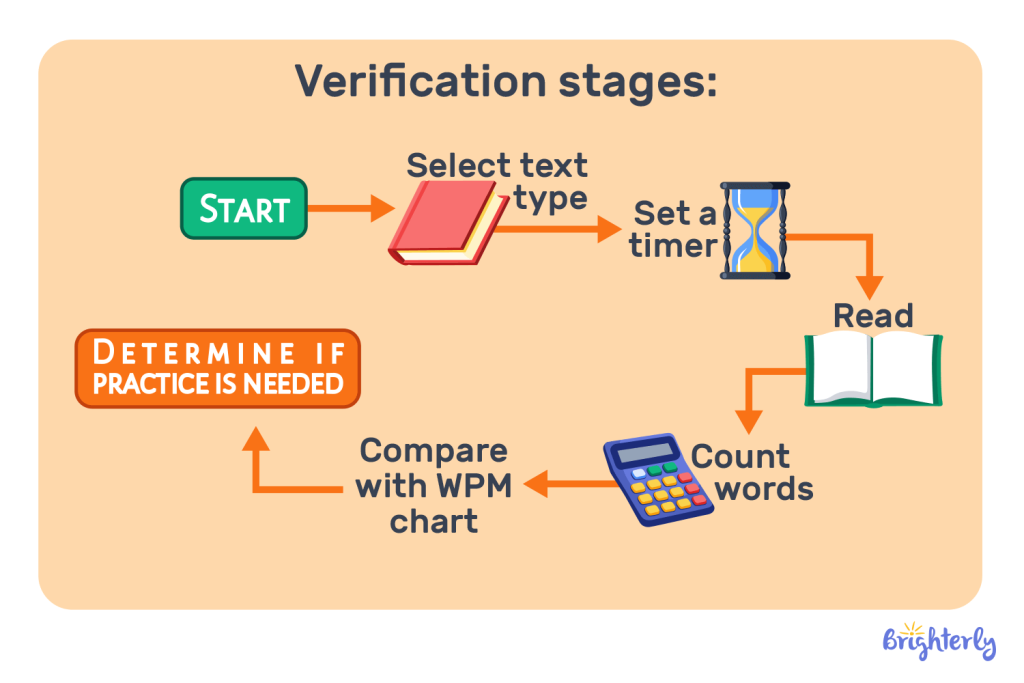
What is a good reading speed by age?
A good reading speed by age is about 60-120 WPM for ages 6 to 9, 120-180 for ages 9 to 12, and 170-200 WPM for ages 12 to 14. However, when defining what’s the average reading speed of your child, I strongly encourage you to take into account their peculiarities and the complexity of the text they deal with.
WPM reading speed: Interesting facts
Ultimately, tracking reading speed can be an enjoyable metric to explore. These are some fascinating facts that will help you better understand its essence:
- What is the average reading speed? Now you have the precise answer to that. But just imagine that some people can read at a pace of over 400 WPM. Although the number sounds impressive, text comprehension is usually severely limited at such a rate. So, it’s not always about numbers.
- Reading speed grows most rapidly with the youngest learners. In some cases, it can double between grades 2 and 4. But then, most pupils experience a plateau effect during the middle school years.
- Average reading speed is one thing, and skimming is another. People can skim text at up to 700 WPM. However, such surface review isn’t enough for an in-depth understanding.
- Reading speed tends to decline in older adults. According to the study, it can be reduced by 30% in individuals aged 55 and above, compared to younger people.
- Reading speed averages differ depending on the countries and languages! According to the OECD PISA reports, some of the champions include Finland, South Korea, Singapore, Canada, and Japan. In the United States, the average reading speed is relatively stable compared to global leaders, but still shows significant variation by grade level.
The underdogs of the rating are primarily the countries of Sub-Saharan Africa and parts of South Asia.
Reading speed chart: World-renowned record-breakers
Finally, I’d like to share a few stories about individuals who managed to break the way we perceive reading speed. Their results are far above the average WPM reading. But hey, don’t try to beat them, as usually the higher the pace, the poorer the comprehension. So, set your priorities right 🙂
- Annie Jones is a six-time champion in the World Speed Reading competition. She was able to read with the speed of 4,200–4,700 WPM while retaining the 67%+ comprehension rate.
- Samson Ajao from Nigeria is the current record holder for the longest session of reading aloud. The event happened in 2024, when he managed to read continuously for nearly 9 days.
- Howard Stephen Berg owns the former Guinness World Records title “World’s Fastest Reader.” He claimed to read up to 25,000 WPM with complete comprehension. However, Guinness no longer recognizes speed-reading claims as official categories, as they are challenging to verify.
What is the average reading speed by age: Conclusion
Now, you’re well aware of the WPM reading speed chart and know the exact numbers to measure your kid’s performance. So, how successfully can they tackle the challenge? Remember that learning to read is much more than just the tempo they can take.
If you want your kid to excel in all aspects of reading and achieve fluency, be sure to address a tutoring professional at Brighterly. After all, they allow you to book free reading lessonand test the functionality without risks. Setting doubts aside, give your child the opportunity for quality education with Brighterly!


